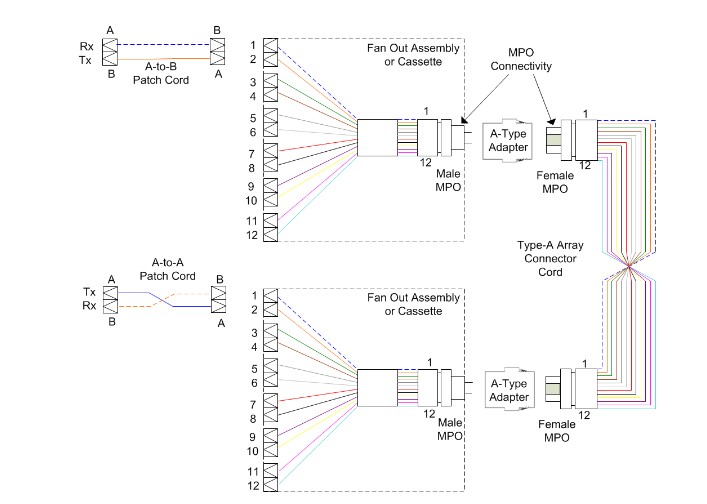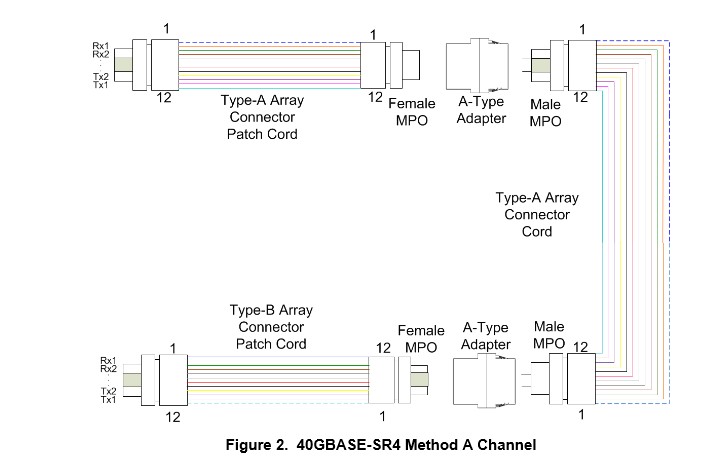Purpose
The purpose of this document is to describe the usage and reason behind the development and characteristics of the MPO to be utilized in 10GASE-SR and 40GBASE-SR4 channels.
Background
MPO connectivity has become widely used throughout the industry not only to reduce cable density but also to prepare for the migration from 10GBASE-SR to 40GBASE-SR.
With the 10GBASE-SR transmission, there are two fibers associated with the channel one fiber for transmit and one fiber for receive. This configuration is often referred to as a duplex channel. The polarity of these channels (TX to RX) is relatively easy to manage from end to end and if polarity correction is required, it is easy to accomplish in the field by rearranging the fibers in the duplexing clip. Also, when two of these connectors need to be mated, an adapter with a split sleeve is used to align the ferrules of the two connectors. Shown below is a typical 10GBASE-SR Method A channel.
In an existing 10G Ethernet fiber infrastructure, LC to MPO cassettes are replaced with MPO adapter panels, and LC to LC patch cords are replaced with MPO patch cords during migration to 40G Ethernet. In this example, three different types of patch cords are required for the migration: Method A/Female to Male, Method A/Male to Male, and Method B/Female to Male. Using patch cords terminated with MPO Connectors, only one type of patch cord needs to be purchased and stocked and can be configured on the fly to replace any of the three needed patch cords.
In the 40GBASE-SR transmission, there are eight fibers associated with the channel four fibers for the TX signal and four fibers for the RX signal. With multiple fibers being utilized, the polarity of the channel becomes harder to manage from end to end. Additionally, mating of two MPO connectors is not completed with an adapter with a split sleeve but rather with alignment pins that are a fixture on the MPO connector. One MPO connects or has alignment holes (this connector is referred to as a female MPO) and the other MPO connector has alignment pins. (this connector is referred to as a male MPO).
These two connectors are mated together in a genderless MPO adapter. Figure 2 shows a typical 40GBASE-SR Method A channel.
When using MPO-based connectivity in the 10G channel, the standard, ANSI/TIA-568C.1-7, calls for a female MPO horizontal cabling infrastructure (as shown in Figure 1) and a male MPO cassette. The male MPO is located within the cassette to protect the fragile alignment pins from damage during installation. In a 40G channel configuration, cassettes are not used and therefore cannot serve to protect the pins. Consequently, in the 40G channel configuration the standard calls for male MPO horizontal cabling (as shown in Figure 2) to protect the alignment pins on the back side of the adapter module rather than have them exposed to possible damage on the end of a patch cord. Male connectors on patch cords pose an additional operational risk to QSFP+ ports should a male connector be inserted due to the QSFP+ ports being configured as male to protect the pins within the port. The following are the products about 40G QSFP+ MTP MPO to QSFP+ Assembly from FS.
QSFP+ MTP/MPO fiber trunk cable assemblies are interconnecting QSFP+ transceivers operating within 40GBASE-SR parallel optics networks. QSFP+ transceivers utilize 12Fibres MPO/MTP interface and perform 40G transmission using 4 x 10G channels (8 fibres: 4 x TX and 4 x RX ). FS MTP/MPO QSFP+ assemblies are built with the highest quality components. MTP/MPO as well low loss Elite versions are offered featuring low insertion loss for demanding high-speed networks where power budgets are critical.
Considering this discussion, to comply with the ANSI/TIA-568C.1-7 cabling guidelines and provide optimal pin protection when migrating from a 10G to 40G cabling configuration, the MPO connectors associated with the horizontal cabling infrastructure must be changed from female to male. Given that existing MPO connectivity does not allow for this alteration in the field without significant risk of fiber or connector damage, it seems that the cabling in the horizontal cabling infrastructure would need to be changed out.
In the Method A configuration shown in Figure 2, there are also two different MPO patch cords necessary to complete the 40G channel. Not only does the horizontal cabling MPO change from female to male, but a Method A cord and Method B cord are needed at the ends to complete the channel to ensure proper polarity.
A Method B configuration holds the same gender issues as Method A when migrating from 10G to 40G, but does not need the two different MPO patch cords to complete the channel.
Testing is another challenge present with MPO horizontal solutions. Some testers have a fixed male MPO interface while others have a fixed female MPO interface. In both cases, the preferred jumper testing method, Method B, per TIA-568-C (TIA-526-14A and TIA-526-7) cannot be used for both the male horizontal and female horizontal cabling infrastructures. In the case where the MPO interface on the tester does not match the MPO in the horizontal infrastructure, a three-jumper method would need to be utilized. The three-jumper method introduces more variability and the possibility for error in the testing.
For example, Figure 3 shows a tester with fixed Male MPO interfaces on the source and meter units. When setting the reference, you will need to use a female-to-female MPO reference cord. After setting the reference, to test a female horizontal cabling infrastructure, a third reference cable with a male end would need to be introduced to properly test the horizontal cabling infrastructure.
In any of these cases changing either the polarity or gender of the standard MPO connector in the field is not recommended due to the complex construction of the connector. Trying to change either of these characteristics in the field is extremely difficult and may lead to damage to the fiber exposed when attempting to replace the connector housing.
MTP MPO Fiber Cable is offered for various applications for all networking and device needs like 100G/40G modules. It uses a high-density multi-fiber connector system built around precision-molded MT ferrule. FS MPO fiber cables are available in UPC and APC finishes, support both multimode and single-mode applications, and have optional lengths available. Our MTP/MPO fiber cable is with push connector IEC 61754-7 and TIA/EIA 604-5A compliant and offers low cost per termination for high-density applications. The MPO/MTP fiber cables are tested with guaranteed quality, and they can be installed easily, which saves time and money.



